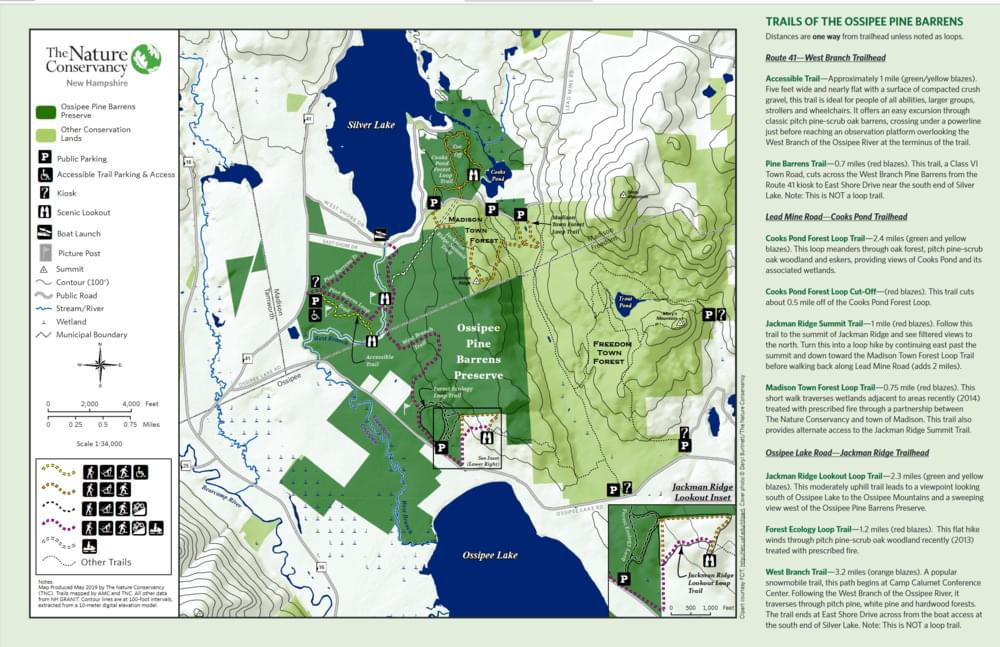Ossipee Lake Rd. Pine Barrens, Freedom
Ossipee Lake Rd. Pine Barrens, Freedom
The Nature Conservancy Ossipee, New Hampshire 03814
Official WebsiteOssipee Lake Road Pine Barrens (Ossipee Lake Alliance) webpage
Ossipee Lake Road Pine Barrens brochure and map
About this Location
7.5 miles of hiking trails in the preserve provide terrific opportunities to explore the Ossipee Pine Barrens Preserve. The 1.3-mile Pine Barrens Loop begins at the preserve parking area along NH-41 in Madison and offers an easy excursion through classic pitch pine/scrub oak barrens, while the 3.2-mile West Branch Trail is a popular snowmobile trail that begins just across from the boat access on the south end of Silver Lake, follows the West Branch, and traverses through pitch pine and hardwood forests before ending at the Camp Calumet Conference Center. A trail leading from the Camp Calument Center parking area up to Jackman Ridge offers excellent views of the pine barrens, the Ossipee Mountains, and Ossipee Lake. Trails off of Leadmine Road provide access to Cook’s Pond and Cook’s River along with an interesting sandy esker. Trails are easy to moderately strenuous. Summer is the prime time to visit the pine barrens when blueberries are plentiful and the songs of whip-poor-wills fill the nighttime air. Fall is beautiful as the scrub oaks and blueberry bushes in the understory turn a brilliant scarlet. You can also canoe or kayak on Cook’s River and Pond from the Town of Madison boat launch on Silver Lake.
The Ossipee Pine Barrens were shaped more than ten thousand years ago when retreating ice age glaciers left behind a broad, deep sandy outwash plain. Too dry and nutrient-poor to support agriculture or many of the more typical forests of northern New England, areas with these sandy-gravelly soil types became known as “barrens.” Despite the tough growing conditions, however, this area is hardly barren – a forest of pitch pine and scrub oak thrives here, rejuvenated over the eons by lightning and human-sparked fires. It’s a patchwork of pine woods and scrub oak: dense and tangled in some places, open and airy in others, with an inviting bed of blueberries and ferns near the ground.
Pine barrens are a globally rare forest type and one of the state’s most endangered landscapes. A combination of flat topography, well-drained soils, and proximity to population centers has resulted in the development and conversion of most of New Hampshire’s original pine barrens. The pine barrens ecosystem of Ossipee, Madison, Freedom, and Tamworth is the last relatively large and intact example in our state. This unique habitat supports a diversity of uncommon wildlife, including nearly two dozen threatened and endangered moths and butterflies – some found nowhere else in New Hampshire. These insects use pitch pine and scrub oak, and understory plants like sweet fern and low-bush blueberry for food and as a place to lay their eggs. The pine barrens also provide a very important breeding habitat for several declining bird species like whip-poor-wills, common nighthawk, and the Eastern towhee. The preserve also includes a mile of frontage on the West Branch River and another mile of frontage on Cook’s Pond and River which drain into Silver Lake.
The Ossipee Pine Barrens not only provide habitat for a diversity of unique and rare plants and animals in New Hampshire, but they also safeguard and recharge the largest stratified-drift aquifer in the state. Residences around Silver Lake and the pine barrens rely on clean drinking water extracted from private and public water supply wells dug into the Ossipee aquifer. Protecting these pine barren properties is an important step in maintaining water quality and clean drinking water resources in the Ossipee watershed.
Pitch pine and scrub oak are uniquely suited to dry, acidic soils of the pine barrens and rely on periodic fires for the regeneration and sustainability of the forest. Mature pitch pines have a thick bark that protects the living tissues of the tree during fire episodes, and their seeds readily germinate in soils exposed after a fire. Scrub oak survives fire by having a taproot that is as large as the above-ground portion of the tree. If the tree is burned by fire, the taproot often survives and can sprout new growth. Several of the rare moths and butterflies that populate the pine barrens have also evolved behaviors to survive and respond to fire, by burrowing under the soil during the burn season.
Features
Restrooms on site
Wheelchair accessible trail
Entrance fee
Content from Ossipee Lake Road Pine Barrens webpage
Last updated November 14, 2023
